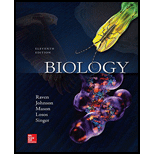
Prezygotic isolating mechanisms include all of the following except
a. hybrid sterility.
b. courtship rituals.
c. habitat separation.
d. seasonal reproduction
Introduction:
The reproductive isolation is achieved through the reproductive barriers which are the evolutionary mechanism or behaviors that prevent organism of a different species from breeding and leads to the prevention of exchange of genetic material. There are two types of reproductive barriers: Prezygotic barrier prevents the fertilization between species and postzygotic barrier prevents the maturation of hybrid zygote formed by the mating of two different species. Prezygotic barrier involves habitat, mechanical, gametic, behavioral, and temporal isolation. Postzygotic barriers involve reduced viability of the hybrid formed, reduced fertility of the hybrid and the breakdown of the hybrid that result in the sterile generations.
Answer to Problem 1U
Correct answer:
Hybrid sterility is the postzygotic barrier in which the produced hybrid formed due to the mating of two different species either does not develop properly (are sterile) or the adults do not survive for long. Therefore option a. is the correct answer.
Explanation of Solution
Reason for the correct statement:
The isolating mechanisms that prevent the formation of a zygote are known as the prezygotic isolation mechanism. It includes prevention of the fusion of gametes, ecological, behavioral, temporal, and mechanical isolation. Hybrid sterility is the postzygotic isolating mechanism in which the hybrid formed will be sterile and will not be able to reproduce.
Option a. is given as “hybrid sterility”.
As, “hybrid sterility is not a prezygotic isolating mechanism”, is the right answer.
Hence option a. is correct.
Reasons for the incorrect statements:
Option b. is given as “courtship rituals”.
The difference in courtship rituals is due to behavioral isolation which is a prezygotic isolating mechanism. So, it is a wrong answer.
Option c. is given as “habitat separation”.
Habitat separation is due to ecological isolation of species which is a prezygotic isolating mechanism. So, it is a wrong answer.
Option d. is given as “seasonal reproduction”.
Temporal isolation occurs when the species do not mate with each other due to their different reproduction seasons. It is also a prezygotic isolating mechanism. So, it is a wrong answer.
Hence options b., c., and d. are incorrect.
There are two types of reproductive isolating mechanisms: The prezygotic isolating mechanism which prevents the fertilization between species and the postzygotic isolating mechanism that prevents the maturation of hybrid zygote formed by the mating of two different species. These mechanisms are the barriers to facilitate successful reproduction and prevent the exchange of genetic material between species.
Want to see more full solutions like this?
Chapter 22 Solutions
Biology
- Explain how the hormones of the glands listed below travel around the body to target organs and tissues : Pituitary gland Hypothalamus Thyroid Parathyroid Adrenal Pineal Pancreas(islets of langerhans) Gonads (testes and ovaries) Placentaarrow_forwardWhat are the functions of the hormones produced in the glands listed below: Pituitary gland Hypothalamus Thyroid Parathyroid Adrenal Pineal Pancreas(islets of langerhans) Gonads (testes and ovaries) Placentaarrow_forwardDescribe the hormones produced in the glands listed below: Pituitary gland Hypothalamus Thyroid Parathyroid Adrenal Pineal Pancreas(islets of langerhans) Gonads (testes and ovaries) Placentaarrow_forward
- Please help me calculate drug dosage from the following information: Patient weight: 35 pounds, so 15.9 kilograms (got this by dividing 35 pounds by 2.2 kilograms) Drug dose: 0.05mg/kg Drug concentration: 2mg/mLarrow_forwardA 25-year-old woman presents to the emergency department with a 2-day history of fever, chills, severe headache, and confusion. She recently returned from a trip to sub-Saharan Africa, where she did not take malaria prophylaxis. On examination, she is febrile (39.8°C/103.6°F) and hypotensive. Laboratory studies reveal hemoglobin of 8.0 g/dL, platelet count of 50,000/μL, and evidence of hemoglobinuria. A peripheral blood smear shows ring forms and banana-shaped gametocytes. Which of the following Plasmodium species is most likely responsible for her severe symptoms? A. Plasmodium vivax B. Plasmodium ovale C. Plasmodium malariae D. Plasmodium falciparumarrow_forwardStandard Concentration (caffeine) mg/L Absorbance Reading 10 0.322 20 0.697 40 1.535 60 2.520 80 3.100arrow_forward
- please draw in the answers, thank youarrow_forwarda. On this first grid, assume that the DNA and RNA templates are read left to right. DNA DNA mRNA codon tRNA anticodon polypeptide _strand strand C с A T G A U G C A TRP b. Now do this AGAIN assuming that the DNA and RNA templates are read right to left. DNA DNA strand strand C mRNA codon tRNA anticodon polypeptide 0 A T G A U G с A TRParrow_forwardplease answer all question below with the following answer choice, thank you!arrow_forward
 Biology (MindTap Course List)BiologyISBN:9781337392938Author:Eldra Solomon, Charles Martin, Diana W. Martin, Linda R. BergPublisher:Cengage Learning
Biology (MindTap Course List)BiologyISBN:9781337392938Author:Eldra Solomon, Charles Martin, Diana W. Martin, Linda R. BergPublisher:Cengage Learning
 Concepts of BiologyBiologyISBN:9781938168116Author:Samantha Fowler, Rebecca Roush, James WisePublisher:OpenStax College
Concepts of BiologyBiologyISBN:9781938168116Author:Samantha Fowler, Rebecca Roush, James WisePublisher:OpenStax College Biology: The Dynamic Science (MindTap Course List)BiologyISBN:9781305389892Author:Peter J. Russell, Paul E. Hertz, Beverly McMillanPublisher:Cengage Learning
Biology: The Dynamic Science (MindTap Course List)BiologyISBN:9781305389892Author:Peter J. Russell, Paul E. Hertz, Beverly McMillanPublisher:Cengage Learning Human Heredity: Principles and Issues (MindTap Co...BiologyISBN:9781305251052Author:Michael CummingsPublisher:Cengage Learning
Human Heredity: Principles and Issues (MindTap Co...BiologyISBN:9781305251052Author:Michael CummingsPublisher:Cengage Learning Biology: The Unity and Diversity of Life (MindTap...BiologyISBN:9781305073951Author:Cecie Starr, Ralph Taggart, Christine Evers, Lisa StarrPublisher:Cengage Learning
Biology: The Unity and Diversity of Life (MindTap...BiologyISBN:9781305073951Author:Cecie Starr, Ralph Taggart, Christine Evers, Lisa StarrPublisher:Cengage Learning





